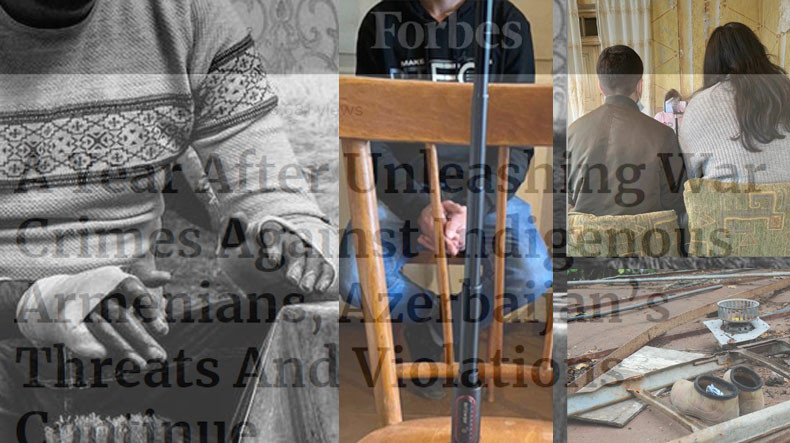
A year after unleashing war crimes against Armenians, Azerbaijan’s threats continue – Forbes
Forbes magazine has published an article on the first anniversary of the 44-day war in Artsakh entitled “A year after unleashing war crimes against indigenous Armenians, Azerbaijan’s threats and violations continue”.
“A year ago today–on September 27, 2020–The Republic of Azerbaijan, with Turkey’s full military support and over 1,000 trafficked Syrian jihadist mercenaries, launched a war against the indigenous Armenians in the disputed territories of Nagorno-Karabakh (Artsakh). Throughout the 44-day war, Azerbaijan’s indiscriminate use of cluster munitions, drones, and artillery rockets included phosphorous bombs which scorched forests causing severe burns among soldiers and civilians.
"Among other heinous war crimes, the Azeri military posted social media videos boasting beheadings and torture of captured Armenian civilians and military. A strong-arm trilateral agreement on November 10, 2020, negotiated between Armenia, Azerbaijan and Russia, ended the war and stationed 2,000 Russian peacekeeping troops in Artsakh,” the article says.
The spoils of the war left nearly two-thirds of the indigenous Armenian lands in Artsakh occupied by Azerbaijan. With over 5,000 Armenians killed, 110,000 displaced, 10,000 fighters wounded and 200 POWs detained illegally in Azerbaijan prisons and tortured–there are still hundreds of unaccounted Armenian MIAs.
"A year later, the Azeri assaults on the Armenian population continue. In the occupied Hadrut Region, Azeri soldiers desecrated Armenian cemeteries. The French Journalist, J-Christophe Buisson tweeted about the masked armed Azeri soldiers who stopped the Artsakh Armenian youth soccer team bus on its way to Armenia for a soccer match. Using a dagger to scrape off the Artsakh flag from the surface of the bus, the soldiers inspected the war-traumatized children’s phones, stating Nagorno-Karabakh is part of Azerbaijan," the magazine says.
The U.S. House of Representatives on September 23, passed the Cardenas-Schiff-Sherman amendment demanding Azerbaijan “immediately and unconditionally return all Armenian” POWs and captive civilians. It also called for a report on Azerbaijani war crimes, use of illegal munitions and white phosphorus against Armenian civilians, and an investigation into the use of U.S. technology in Turkish drones that targeted Armenian civilians during the 2020 war.
Forbes reminds that the Republic of Armenia “instituted proceedings against the Republic of Azerbaijan before the International Court of Justice,” the principal judicial organ of the UN. Earlier this year, Armenia also filed interstate complaints against Turkey with the European Court of Human Rights.
"Human rights abuses and violations of international humanitarian law were widespread after Artsakh was attacked. Mercenaries and jihadis were deployed from Syria and Libya under Turkey's command. These perpetrators were responsible for horrific crimes, which are ongoing despite the ceasefire agreement. Columbia University's Artsakh Atrocities Project has been documenting events. We hope that the information we've compiled can be used to hold Turkey and its cohorts accountable for its wanton abuse of civilians, including women and children, as well as cultural crimes," says David L. Phillips, Director of the Program on Peace-building and Rights Institute for the Study of Human Rights, at Columbia University.
While Azerbaijan refutes the legal right to self-determination of the Armenian population of Artsakh, last year’s war echoed memories of September Days 1918 and the systematic extermination of nearly 15,000 Armenians in Nakhichevan and Artsakh. Similar to their brethren Ottoman Turks’ occupation of Armenian properties and landmarks during the 1915 Genocide of 1.5 million Armenians, Azerbaijan continues desecrating Artsakh’s churches, ancient cemeteries, sacred cathedrals and historic sites dating back a millennium, the article says.
Citing recent Caucasus Heritage Watch (CHW) report, Hakim Bishara reports in Hyperallergic how “over a dozen Armenian churches, cemeteries, sacred cross-stones (Khachkars), and other cultural properties have either been destroyed, damaged, or threatened by Azerbaijan.” Azerbaijan’s President Aliyev ordered the removal of medieval Armenian inscriptions from churches, calling them “fake” and rebranding the sites as “ancient Azerbaijani” landmarks. The 2019 groundbreaking forensic reportage in Hyperallergic by Sarah Pickman and Simon Maghakyan details Azerbaijan’s long history of erasure and destruction of indigenous Armenian sites including “89 medieval churches, 5,840 intricate cross-stones, and 22,000 tombstones.”
Well-paid U.S. PR agencies, lobby groups ensure Azerbaijan’s cover-ups
Well-orchestrated PR campaign machinery, constructed in advance of last September’s war by high-end U.S. PR agencies and lobby groups, orchestrated a widespread misinformation campaign against Armenia, as Azerbaijan carpet bombed Artsakh, Forbes says.
Anti-Armenian reports and articles germinated across top media outlets most prominently led by Carlotta Gall, The New York Times’ Istanbul bureau chief. International organizations such as Amnesty International and Human Rights Watch issued pro-Azerbaijan reports accusing Armenia of instigating the war, and then changed their claims. DataPoint Armenia offered the most comprehensive analysis on the “social media narrative warfare during the war” or “astroturfing” concluding that pro-Armenian social posts had “small effect on international audiences.”
While diaspora Armenian communities demanded justice against the Azerbaijan-Turkey alliance, diaspora Turks unleashed hate crimes defacing Armenian churches, schools and cemeteries. When France sent humanitarian relief aid to Artsakh, calling for the region’s recognition, Azerbaijan’s parliament called for France “to be stripped of its mediation role in the Nagorno-Karabakh conflict to punish the French Senate.”
Neither Azerbaijan nor Turkey has earned human rights awards in recent years.
Newsfeed
Videos






























